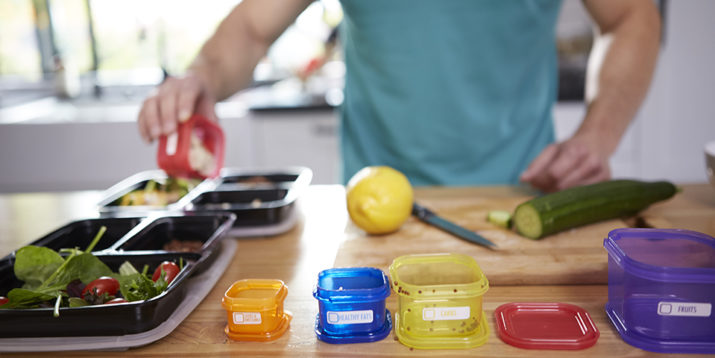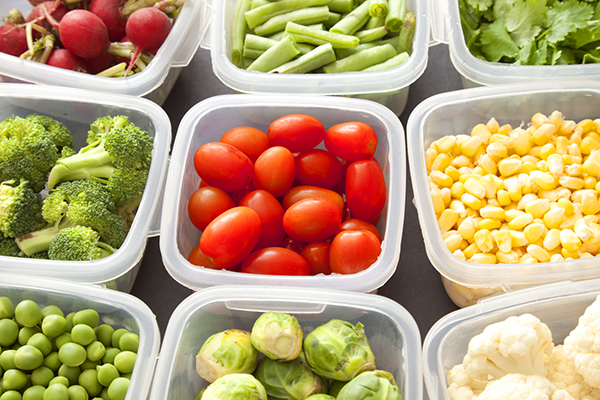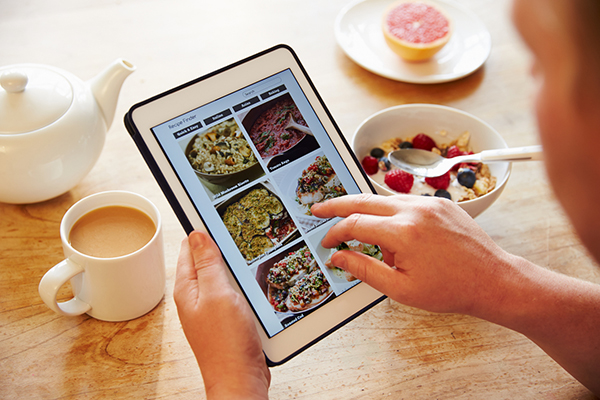Meal-Prep Tips: A Beginner’s Guide to Meal Prepping

What is meal prepping? Why would I prep all my meals in advance?
This meal-prep guide for beginners will help you get a handle on how to begin, how to choose your meals, how to make a meal-prep grocery list, and much more.
Why Meal Prep?
“Be prepared.”
t’s a slogan that’s stood the test of time because the relationship between looking ahead and successfully meeting one’s goals is undeniable.
When it comes to what you eat and how you eat, preparedness matters if you want to reach your nutrition and fitness goals.
What Is Meal Prep?
Amy Shapiro, M.S., R.D., C.D.N. of Real Nutrition NYC, defines meal prepping as preparing, cooking, or packaging food for three to four days in advance so you know exactly what and how much you are eating.
Having a healthy meal ready to enjoy can help you say no to unhealthy food choices.
Tempted to go through the drive-thru on the way home to save time? No point when you’ve already got a delicious meal at home waiting for you.
Taco truck pull up in front of the office again? No sweat — you’ve already packed a hearty lunch you’re looking forward to.
Someone brought donuts to the office? Satisfy your snack craving with these meal-prep snack ideas.
Research shows a link between the amount time of people spend on prepping food at home and the quality of their diet. What’s more, meal prepping can be a great time-saver.
“I think of meal prepping as a way to put lunch, breakfast, or even dinner on autopilot for the week,” says Atlanta-based dietitian nutritionist Marisa Moore, M.B.A., R.D.N., L.D. “You do all of the major chopping, cooking, and cleaning on one day.”

How to Meal Prep
1. Start Small
Planning ahead and prepping your meals can be a great way to make more healthy choices and avoid temptation.
If you’re not used to batch cooking, start with prepping one or two days’ worth of meals at a time.
“I recommend starting small with meal prep for a couple reasons,” says Moore. “It can take a couple hours to get through the chopping, cooking, and cleaning [for a week’s worth of meals]. If you try to do too much too soon, you may be overwhelmed and not want to do it again.”
Moore adds that starting small will allow you test one or two recipes to see how you like them and just how much of them you actually eat.
“You wouldn’t want to make too much food and end up wasting it.”
2. Stock Up on Kitchen Essentials
You don’t need a ton of fancy kitchen equipment to make healthy meals at home. Here are some basic kitchen tools you might find helpful if you don’t have them already:
- Portion Control containers
- Bento-style meal-prep containers
- Pyrex meal-prep containers
- Mason jars
- Chef’s knife
- Measuring cups and spoons
- Cutting board
- Spatula
- Sauté pan, small saucepan, baking sheet
- Mixing bowls
- Slow cooker or Instant Pot (optional)
- Blender or food processor (optional)
3. Pick a Day to Meal Prep
Moore recommends starting on a Sunday or Monday. Sundays often work well since most people have a little extra time.
She adds that people also tend to be more motivated to engage in healthy behaviors at the beginning of the week.
“Meal prep is a great way to carry that enthusiasm throughout the week with just a little effort up front.”

4. Come Up With Meal-Prep Ideas
Planning your meals for the week doesn’t have to be complicated.
It might seem a little daunting at first, but it’s surprising how many different meals you can make with just a limited number of ingredients.
Beachbody offers free meal plans that have already done all the heavy lifting for you.
Most are five days long, and there are vegetarian meal preps, vegan meal preps, grain-free meal prep, no-cook meal preps, and more.
The meal preps are categorized by calorie level, and most include step-by-step instructions and a grocery list.
If you’re not ready to commit to a full meal prep just yet, keep it simple. LA Life Chef Seth Santoro suggests no-fuss combinations like chicken, brown rice, and broccoli for dinner, and salmon, roasted carrots, and spinach for lunch.
To add flavor without calories, stock up on herbs and spices.
Once you have your meal-prep recipe list, check your pantry and fridge for ingredients, make a list, and then you can head to the store prepared.
And if you’re the type who tends to wander aimlessly around the aisles, here are some ideas to save time, money, and your sanity:
12 Food Storage Tips to Make Your Groceries Last Longer
The Ultimate Grocery Shopping Survival Guide
5. Batch-Cook Staples to Use Later
Once you’re comfortable meal prepping, Seth Santoro recommends preparing staples — like rice, oats, lentils, and yams — in bulk.
You’ll return to them again and again, and they can take the longest to cook.
“You can make a pot of rice, use some now for a meal, refrigerate a portion, and freeze a portion to be used later,” he says.
How to Make Meal Prep Easy:
- Include some no-cook recipes in your meal prep. Snacks like Shakeology and foods that don’t require cooking (like salads and overnight oats) can help save time in the prep process.
- When prepping, use the oven to cook several things at once. Veggies can generally roast together, and there’s a reason sheet-pan dinners are becoming so popular — no muss, no fuss.
- Don’t shy away from the Crock-Pot or the Instant Pot. They’re super time-savers — just add ingredients, set, and forget. While it’s doing the work on one recipe, you have time to focus on another.
